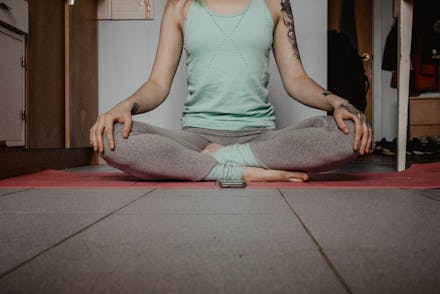4 therapist-approved ways to get grounded when you're feeling anxious

Spring is in the air and, in many places, it seems like the world is reopening. But the combination of the extended stress of the pandemic, vaccine anxiety, and the reality that the pandemic isn’t over yet has a lot of us feeling untethered. Trying to figure out what to do next often leads to panic. Our anxieties are understandable and perhaps inevitable, but therapists have some grounding techniques for anxiety when it feels like the world is spinning.
4-7-8 breathing
I always find it a little bit condescending when I’m freaking out and someone tells me to take a deep breath. Sometimes, just that brief pause helps, but other times it’s not enough. If you’re like me and you need a little more guidance, try the tried and true 4-7-8 breathing technique. “Slowly take a deep breath in for three seconds through your nose as if you are filling up a balloon inside your belly,” says Susan George, an Ohio-based psychotherapist. “Hold your breath for 4 seconds. Then, slowly release your breath through your mouth for 5 seconds. For those who are more experienced, breath in for 4 seconds, hold for 7 seconds, and release for 8 seconds.”
George recommends repeating this breath cycle 10-12 times. “Deep breathing allows for an increase in oxygen, which helps your body and muscles to relax naturally,” she explains. When we are anxious, our muscles tighten up, our heart rate increases, and our thoughts tend to race, she says, and when we do 4-7-8 breathing, it slows down our heart rate, which is a cue to our bodies that it’s okay to relax. I’ve used this breathing technique to help friends on the brink of road rage and when I’m trying to sleep.
S.T.O.P
When you’re in a crazy-making situation and you get anxious, it’s easy to fly off the handle. Save your energy for dismantling the white cis-heterocapitalist patriarchy, y’all. “The first step is simply to recognize you are feeling triggered,” says Elana Miller, a psychiatrist in Los Angeles. She uses the acronym S.T.O.P. as a way to interrupt the reactivity we often experience in stressful moments. The S stands for Stop, the T stands for Take a Breathe, the O stands for Observe Now, and the P stands for Proceed Last.
Miller explains how to use the S.T.O.P. method in your everyday life: “Say someone starts yelling at you,” says Miller. “Say to yourself Stop. Stop is a pause before reactivity. Next, you take a deep breath. A good, solid, deep breath takes at least a couple seconds. The breath serves to ground you in your body, ground you in the moment, and relax you a bit. O stands for Observe Now, so instead of following the narratives in your head about what's wrong with this situation and how bad you feel, take a moment to pay attention to your body. Pay attention to the emotions behind these physical sensations. Often when you understand the underlying emotion, the power of the anxiety diminishes. P stands for Proceed Last, you continue on with whatever you were doing — but in a calmer, more clarified headspace.”
The sense technique
When I get anxious, I sometimes get so locked in my head that I feel like I’m not in my body and the world around seems, well, kind of blurry. The 5-4-3-2-1 sense technique is my go-to when I feel that way. There’s a reason for that. “Using your five senses to notice things around you to bring you a sense of calm and peace,” says Annie Hsueh, a psychotherapist in California.
Here’s how to do it: “Name 5 things you see, name 4 things you hear, name 3 things you can touch, name 2 things you can smell, name 1 thing you can taste.” Easy, right? Except that not only does this technique put you back in the real world, I can tell you from experience that it’s often difficult to name things that you can feel, smell, or taste, and deliberating about what the flavor in your mouth actually ease gives you even more time to calm down a bit.
Sit on the ground
It’s no accident that when we feel scattered, we call it being “ungrounded.” Luckily, the actual ground is always with us. “By sitting on the ground, or actually on the earth if you're really about it, we can sink into the sensation of being supported and re-center ourselves,” says Shena Young, a psychologist and bodyworker in Los Angeles says. When we feel ourselves floating off into the clouds of the unknowns, fears of the future, or the pains of the present, it just makes sense to get close to the ground, Young says.
You can just sit on the ground, of course, but Young also has some advice about how to make the most out of it. “I invite clients to stop, drop, and sit on the floor or earth,” Young says. “Find a comfortable seated shape, maybe cross-legged, and place either the finger tips or the palms of the hands on the earth beside the hips.”
Deepen your breath, lengthen the spine, and point the crown of your head towards the sky. Try not to be hurried about it. Chances are good that hurrying is part of what made you feel ungrounded in the first place. “Take all the time you need there,” says Young. She also recommends taking a moment before you get up to notice any changes in your body and mind.